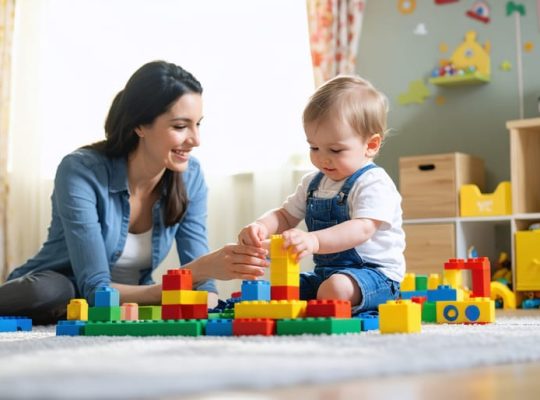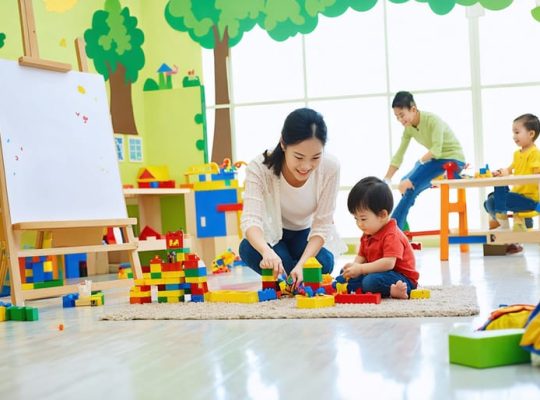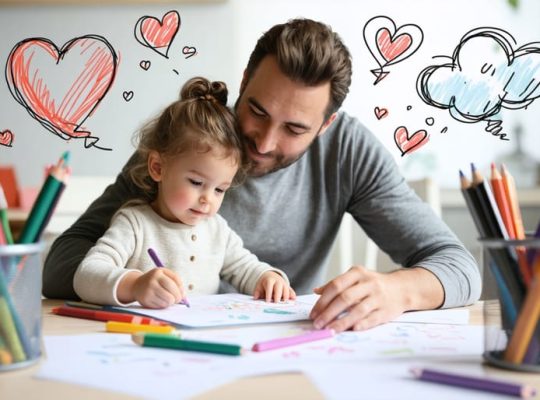Choosing between play-based and Montessori education shapes your child’s crucial early childhood development stages in fundamentally different ways. While both approaches nurture young minds, they follow distinct philosophies that can significantly impact your child’s learning journey and your relationship with them.
Play-based learning embraces spontaneous discovery through unstructured play, where children lead their learning adventures with gentle adult guidance. Imagine your child building elaborate block towers while naturally exploring physics concepts, or developing social skills through imaginative playground scenarios. Montessori, conversely, offers a carefully structured environment where children work independently with specially designed materials, mastering specific skills at their own pace.
Parents often wonder which approach will better support their child’s development while strengthening their parent-child bond. The truth is, both methods can create powerful learning experiences – the key lies in understanding your child’s unique personality and learning style. Some children thrive with Montessori’s orderly approach, while others flourish in play-based settings’ creative freedom.
Let’s explore how each method shapes your child’s development and discover which approach might best serve your family’s educational journey.
Understanding Play-Based Learning
Key Elements of Play-Based Learning
Play-based learning centers around the natural way children explore and understand their world through unstructured play. The benefits of play-based learning are rooted in its core elements: child-led exploration, imaginative play, and social interaction.
At the heart of this approach is free play, where children choose their activities and set their own pace. Teachers act as facilitators rather than instructors, creating rich environments that spark curiosity and learning opportunities. They observe children’s interests and extend learning through gentle guidance and thoughtful questions.
Key components include dramatic play areas, building blocks, art stations, and outdoor exploration spaces. These environments encourage children to develop problem-solving skills, emotional regulation, and creativity through hands-on experiences. Social skills naturally evolve as children collaborate, negotiate, and share during play.
Dr. Sarah Chen, an early childhood expert, explains, “When children lead their own play, they develop executive function skills and build confidence in their abilities. They learn to take appropriate risks and develop resilience through trial and error.”
Unlike more structured approaches, play-based learning emphasizes the journey of discovery rather than specific academic outcomes, allowing children to develop at their own pace while maintaining their natural joy for learning.
Parent Role in Play-Based Activities
In play-based learning environments, parents take on the role of engaged facilitators rather than direct instructors. They create safe, stimulating spaces where children can explore freely and follow their natural curiosity. Parents observe their children’s interests and provide appropriate materials and gentle guidance when needed.
A key aspect of the parent’s role is joining in the play when invited, following the child’s lead rather than directing the activity. This might mean becoming a customer in their pretend shop or helping build a block tower according to their vision. Parents also ask open-ended questions that encourage critical thinking and creativity, such as “What do you think might happen if…?” or “How else could we solve this problem?”
Parents in play-based settings help children process their experiences through gentle reflection and conversation. They validate emotions, celebrate discoveries, and support problem-solving efforts. This approach strengthens the parent-child bond while fostering independence and confidence.
Setting up inviting play spaces, rotating materials to maintain interest, and ensuring adequate unstructured play time are also important parental responsibilities. The goal is to create opportunities for natural learning while maintaining a warm, supportive presence that encourages exploration and growth.
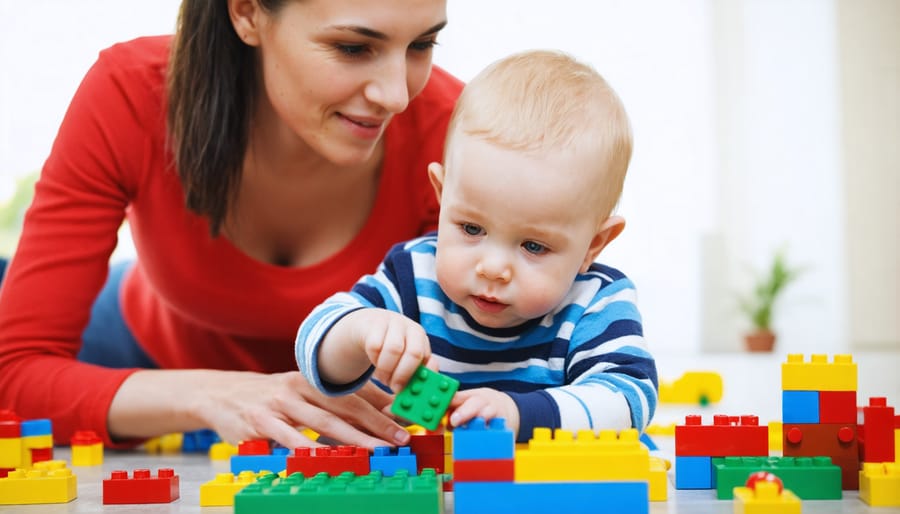
The Montessori Method
Montessori Principles for Parent-Child Interaction
Montessori education emphasizes respect for the child’s natural development and independence, which extends to parent-child interactions. Parents are encouraged to become observers and guides rather than directors of their child’s learning journey. This means creating an environment where children can safely explore and make choices while feeling supported.
Key principles include speaking to children at eye level, using clear and respectful language, and avoiding baby talk. Parents should demonstrate activities once and then allow children to practice independently, offering help only when requested. This builds confidence and promotes problem-solving skills.
Another important aspect is preparing the home environment to support independence. This means having child-sized furniture, accessible materials, and organized spaces where children can complete daily tasks by themselves. Parents should resist the urge to interrupt their child’s concentration when they’re engaged in an activity.
Montessori also encourages parents to involve children in everyday activities like cooking, cleaning, and gardening. These practical life experiences become valuable learning opportunities and strengthen the parent-child bond. The goal is to create a relationship based on mutual respect, trust, and understanding, where both parent and child feel valued and capable.
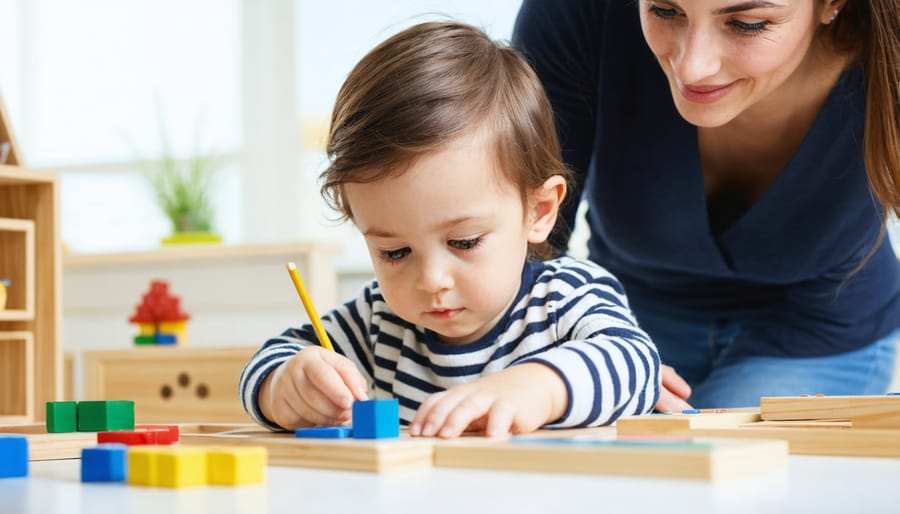
Structured Freedom in Montessori
The Montessori approach uniquely balances structure and freedom, creating an environment where children can explore independently within carefully designed boundaries. Unlike completely free play, Montessori classrooms feature thoughtfully prepared spaces with specific materials and activities that children can choose from.
A key element of this structured freedom is the concept of “work cycles,” where children engage with materials that interest them for extended periods. While they have the freedom to select their activities, these choices are curated to support developmental goals and learning objectives. For instance, a child might choose between arranging number rods, practicing letter sounds, or working with practical life materials.
Teachers act as guides rather than instructors, observing children’s interests and introducing new materials when appropriate. This approach helps children develop self-discipline and internal motivation while working within a framework that ensures their activities remain purposeful and educational.
The structured environment also promotes social skills through clear guidelines about respecting others’ space and materials. Children learn to wait their turn, work independently or collaborate when appropriate, and maintain their learning environment – all while feeling empowered by their ability to make meaningful choices within these parameters.
Bonding Through Different Approaches
Emotional Connection Opportunities
Both play-based and Montessori approaches offer unique opportunities for emotional connection, though they foster these bonds in different ways. In play-based settings, caregivers often actively participate in children’s imaginative play, creating natural moments for shared joy and emotional expression. When a parent or teacher joins a tea party or helps build a block tower, they’re not just playing – they’re creating lasting emotional memories and trust.
Montessori environments cultivate emotional connections through respectful observation and guided independence. When adults step back and trust children to explore independently, they communicate a powerful message of confidence in the child’s abilities. These moments of silent support can be deeply bonding, especially when children look back to share their achievements with a trusted adult.
Both methods emphasize positive reinforcement, but express it differently. Play-based settings often feature enthusiastic celebration and shared excitement, while Montessori environments tend toward quiet acknowledgment and subtle encouragement. Parents report meaningful connections in both scenarios – whether it’s laughing together during messy sensory play or sharing a proud smile when a child masters a new practical life skill.
The key is consistency and presence. Whether you’re actively playing alongside your child or mindfully observing their independent work, your emotional availability matters more than the specific approach you choose. Children in both environments learn to trust their caregivers and develop secure attachments when adults respond sensitively to their needs.
Communication and Trust Building
Both play-based and Montessori approaches offer unique opportunities for strengthening parent-child relationships, though they do so in different ways. In play-based settings, parents often become active participants in their child’s imaginative world, fostering natural conversations and emotional connections through shared experiences. This joint participation creates countless moments for meaningful interaction and trust-building.
Montessori environments, while structured differently, encourage a different kind of communication dynamic. Parents learn to observe their children’s independent choices and respect their autonomy, which builds trust through demonstrated confidence in the child’s abilities. This approach often leads to more thoughtful, purposeful conversations about the child’s interests and discoveries.
Dr. Sarah Chen, a child development specialist, notes: “When parents engage with their children in either setting, they’re creating safe spaces for open dialogue. The key difference lies in how that engagement manifests – active participation in play-based settings versus supportive observation in Montessori environments.”
Both methods emphasize positive reinforcement and respect for the child’s perspective, though they express it differently. Play-based settings might involve more immediate verbal praise and physical interaction, while Montessori focuses on acknowledging effort and supporting independent achievement. Parents report that both approaches can lead to stronger bonds, with children feeling more secure in expressing themselves and seeking guidance when needed.
Making the Right Choice for Your Family
Considering Your Child’s Personality
Every child is unique, and recognizing your child’s individual child personality types is crucial when choosing between play-based and Montessori approaches. Some children thrive in highly structured environments, while others need more freedom to explore and express themselves.
Consider how your child approaches new situations. Do they jump right in, or do they prefer to observe first? Children who are naturally cautious might feel more comfortable in a Montessori setting, where they can work at their own pace with clearly defined materials and activities. More spontaneous, energetic children might flourish in a play-based environment that encourages free expression and social interaction.
Pay attention to your child’s learning style too. Does your little one learn best through hands-on experiences, or do they prefer guidance and demonstration? Montessori education emphasizes independent exploration with specific materials, while play-based learning offers more collaborative and imaginative opportunities.
Your child’s social preferences matter as well. Some children are natural leaders who enjoy group activities, making play-based settings particularly appealing. Others might prefer working independently or in smaller groups, which aligns well with the Montessori approach.
Remember that neither approach is inherently better – it’s about finding the right fit for your child. Observe how your child responds to different types of activities at home. Do they gravitate toward structured tasks like puzzles and sorting games, or do they prefer open-ended creative play? These natural inclinations can help guide your decision and ensure your child feels comfortable and confident in their learning environment.

Blending Approaches for Best Results
Creating a balanced learning environment doesn’t mean choosing strictly between play-based and Montessori methods. Many successful educators and parents have found that combining elements from both approaches can provide children with the best of both worlds.
Start by identifying the strengths that resonate most with your child. For example, you might incorporate Montessori-style practical life activities in the morning, allowing your child to develop independence through tasks like preparing their own snack or organizing their belongings. Later in the day, you could transition to free play sessions where imagination and creativity take center stage.
Consider creating designated spaces that reflect both philosophies. One area might feature carefully organized Montessori materials that promote focused learning and skill development, while another space could be dedicated to open-ended play with blocks, dress-up clothes, and art supplies.
Structure your day with a mix of child-led and guided activities. You might begin with a Montessori work period where children choose from prepared activities, followed by unstructured play time that allows for social interaction and creative expression. This balanced approach helps children develop both concentrated work habits and imaginative thinking.
Remember that flexibility is key. Observe your child’s responses and adjust the balance accordingly. Some children might thrive with more structure, while others need additional free play time. The goal is to create an environment that nurtures both independence and creativity while supporting your child’s unique developmental journey.
By thoughtfully combining these approaches, you can create a rich learning environment that honors both the structured learning of Montessori and the creative freedom of play-based education.
Both play-based and Montessori approaches offer unique benefits for child development and learning. As we’ve explored throughout this article, each method has its own strengths in fostering independence, creativity, and essential life skills. The key is understanding that there’s no one-size-fits-all solution when it comes to early childhood education.
Consider your child’s personality, learning style, and individual needs when making this important decision. Some children thrive in the structured independence of Montessori environments, while others flourish in the creative freedom of play-based settings. Your family’s values, schedule, and resources should also factor into your choice.
Remember that you can incorporate elements from both approaches at home. For instance, you might create a Montessori-inspired learning corner while still maintaining plenty of free play opportunities. The most successful educational experiences often come from finding the right balance for your unique situation.
Trust your parental instincts and observe how your child responds to different learning environments. Stay connected with teachers and other parents to learn from their experiences, and remain flexible – what works today might need adjustment as your child grows and develops.
Most importantly, focus on creating a loving, supportive environment where your child feels safe to explore, learn, and develop at their own pace. Whether you choose play-based, Montessori, or a combination of both, your engagement and support remain the most crucial factors in your child’s early education journey.


